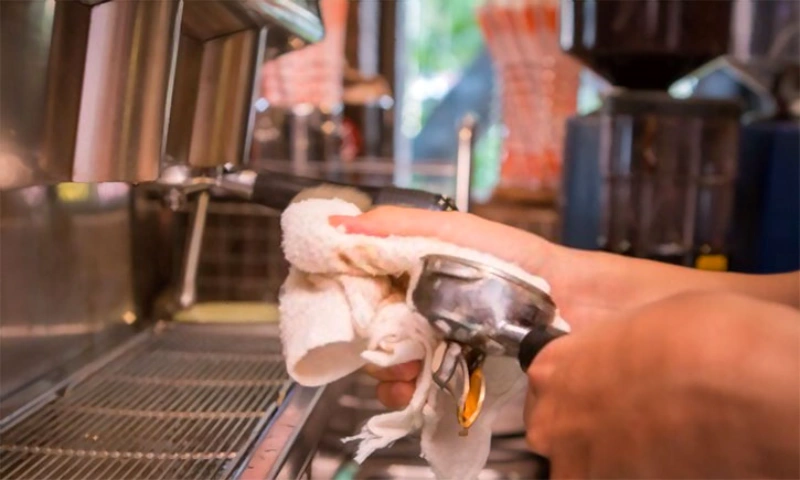Let’s face it: we tend to enjoy having a nicely cooked coffee in our homes – unless you don’t take it. True, as long as the coffee tastes great, you’ll never want your cup to run dry. However, what the majority do not know is that great coffee is a courtesy to the coffee maker. Whether you’ve got a single-cup coffee maker or a larger one, you need to clean it regularly to make the difference. According to a recent survey, 50% of household machines contain mold and yeast.
So, how do you ensure you don’t drink up bacteria or germs in your coffee maker? The answer is quite simple. You need to know how to clean coffee makers. Read on as we have prepared a step-by-step guide on how to go about cleaning coffee maker machines. What’s more, we will also provide you with an insight on how to deep clean it with vinegar or with other items you might have in your home.

The once-in-a-month primary cleaning method
This method is ideal for drip coffee makers. It entails cleaning the removable parts, such as the coffee carafe and the reusable coffee filters. Note that it is advisable to use a degreasing dish soap that is, preferably, fragrance-free to clean your coffee maker.
Remove the removable parts and clean them with dish soap
After using your coffee maker for some time, you will realize that there will be grinds, coffee, and oil residues that are left at the bottom of your coffee maker. For this reason, it is imperative to remove the removable parts and handwash them in the sink with warm and soapy water. Alternatively, you can also use the dishwasher to clean them. The majority of coffee maker parts are dishwasher-safe.
Don’t forget to wipe down the warming plate and its outside where spills can burn on. Also, leave the reservoir lead open to dry. Germs survive better in moist conditions.
Clean it with vinegar once a month
Talking about germs, cleaning your coffee maker with vinegar is one of the best ways to kill them. Hard water minerals tend to harbor germs- over time. Once you notice your coffee maker is taking longer to drip, it might be the right time to cleanse and decalcify it.
Mix water with an equal amount of vinegar, position the pot in place, and turn on the machine. What’s more, don’t forget to place a paper filter into the empty basket. Turn on the machine after running for some time and let the solution settle for 30 minutes or so. After doing so, turn it back on and rinse the solution. Don’t forget to insert a new paper filter after rinsing.
Wash your carafe with a little rise and carafe

It is imperative to wash your coffee maker with a carafe every time you use it. However, if it still looks dingy over time, wash it with sudsy water, a little rise, and warm water. Fill in the pot with the mixture and swirl it around to loosen any junk. Additionally, you can use a scrub sponge to scrub off any debris. Finally, rinse it with water and leave it to dry.
You can repeat the process twice or thrice with water- depending on the intensity of the dirt. Notably, ensure you use pure water only when brewing to obliterate the remaining vinegar. Empty the water after every brew to ensure your coffee maker is entirely vinegar-free.
Finally, after going through all the above steps, your coffee maker will be ready to start brewing quality coffee again. You should notice the change in the taste immediately after making your first cup of coffee after a successful cleaning.
Other tips and options
You might be wondering what other options you can incorporate when cleaning coffee makers. If you don’t have vinegar in your home, you will be glad to hear that there are natural and effective options that will produce exceptional results.
For starters, you can swap the white vinegar with apple cider vinegar. The downside of apple cider vinegar is that it has a healthier state, which might make it harder to remove or might linger for some time. Regardless, if appropriately rinsed, it is quite useful.
Apart from that, you can also use lemon juice. Switch vinegar with lemon juice and mix it with equal portions of water. While using any of these options, ensure you finish your cleaning with two brews of pure water, as highlighted above.
That’s not all; you can try using baking soda instead of vinegar. Add one part of baking soda to four cups of warm water. The reaction should do just fine for your cleaning process. Nonetheless, you might need to remove the filter first before brewing the mixture.
Remember, you are required to stir the baking soda and warm water mixture separately before putting them into the mixer. The reason is to avoid clogging or clumping up your coffee mixture. Finish up with two more brews of just water as in the other processes.
One more tip: while conducting any of the above cleaning processes, ensure you pay close attention to the electrical base. Of course, you don’t want to electrocute yourself in the process. Ensure there are no naked live wires before embarking on your cleaning process.
Note that the power code, plug of your dishwashable coffee maker, and the electrical base are not dishwasher-safe. Immersing them in water or other liquids might damage them.
Final thoughts
A clean coffee maker machine might not be a priority to the majority of homeowners, but knowing how to clean electric machines is critical. There is no doubt that if you put the above tips into consideration while cleaning your coffee maker, you will always get the highest quality out of your machine.
Consequently, if, knowing all the tips/useful info we’ve provided you with, you’re still puzzled about what to look for when shopping, here is a helpful buying guide on budget coffee makers.
James is the owner of North. After working at Nick’s on Broadway, James moved to Red Fez and put his knowledge to the test with hot dog R&D. He assisted in the launch of Momofuku Ko in NYC In 2008. And a year later, James was part of Christina Tosi’s team for Momofuku Milk Bar as their bread baker.

